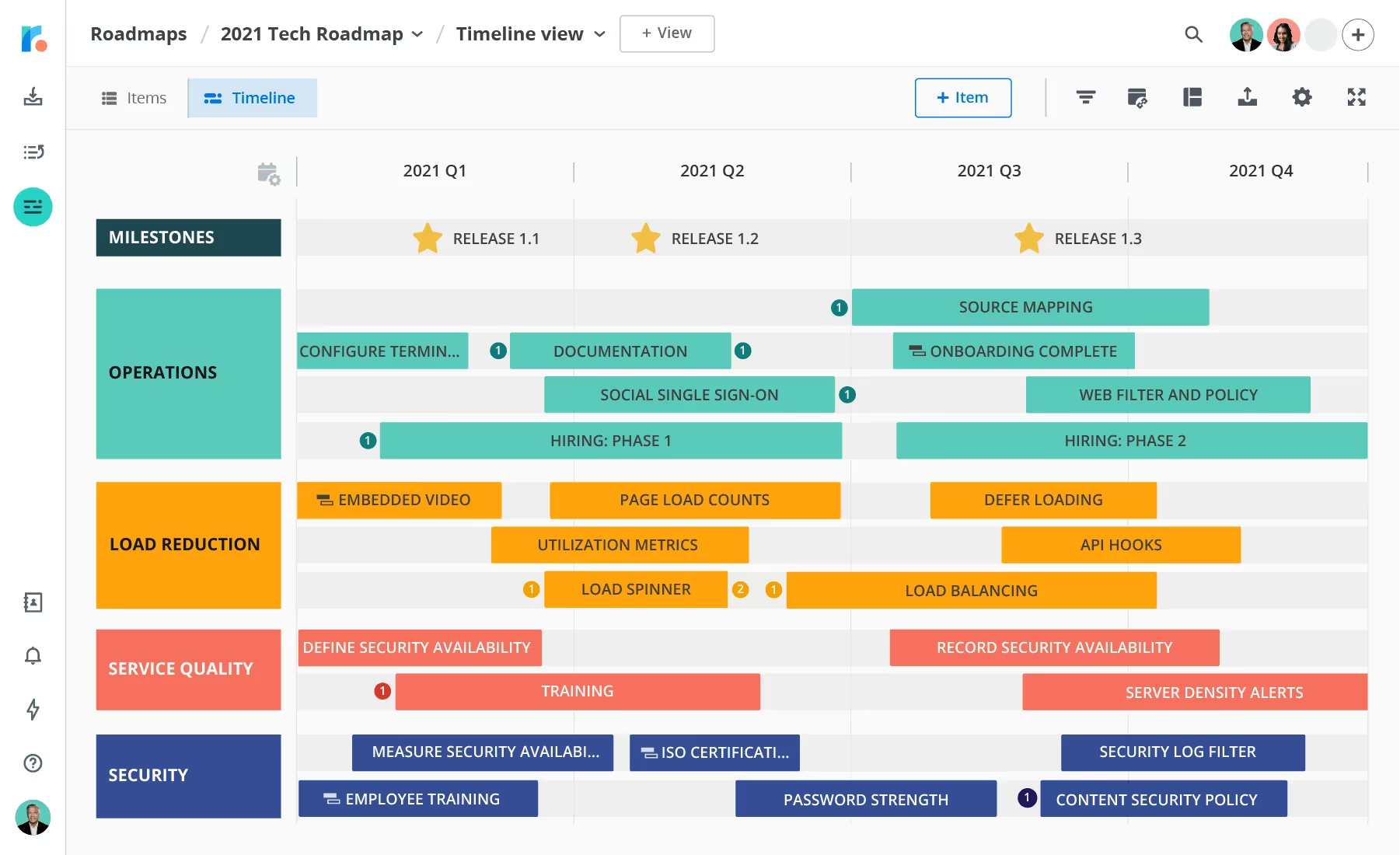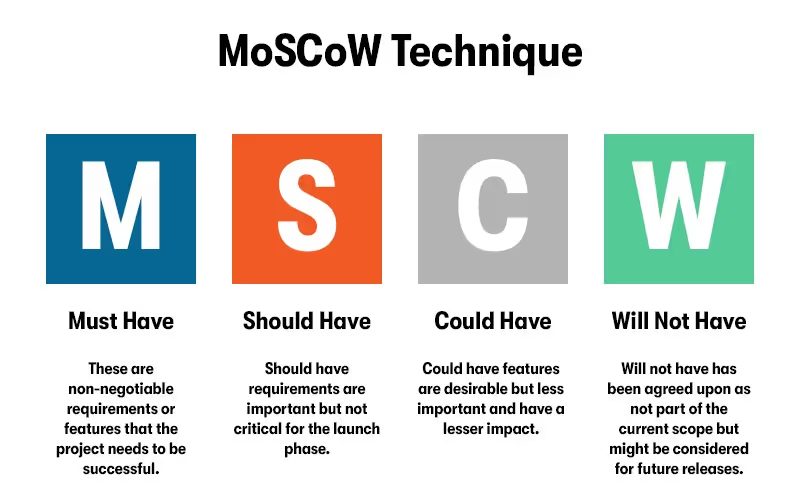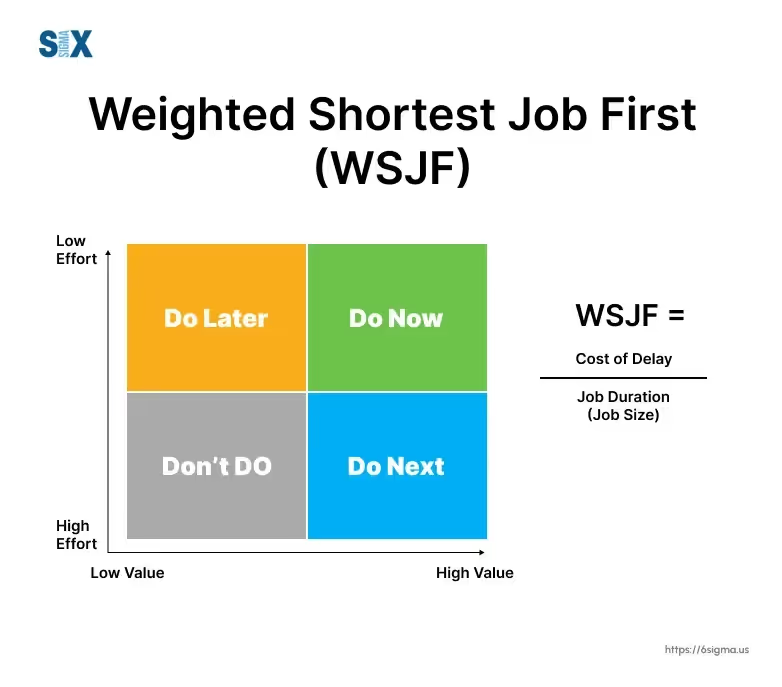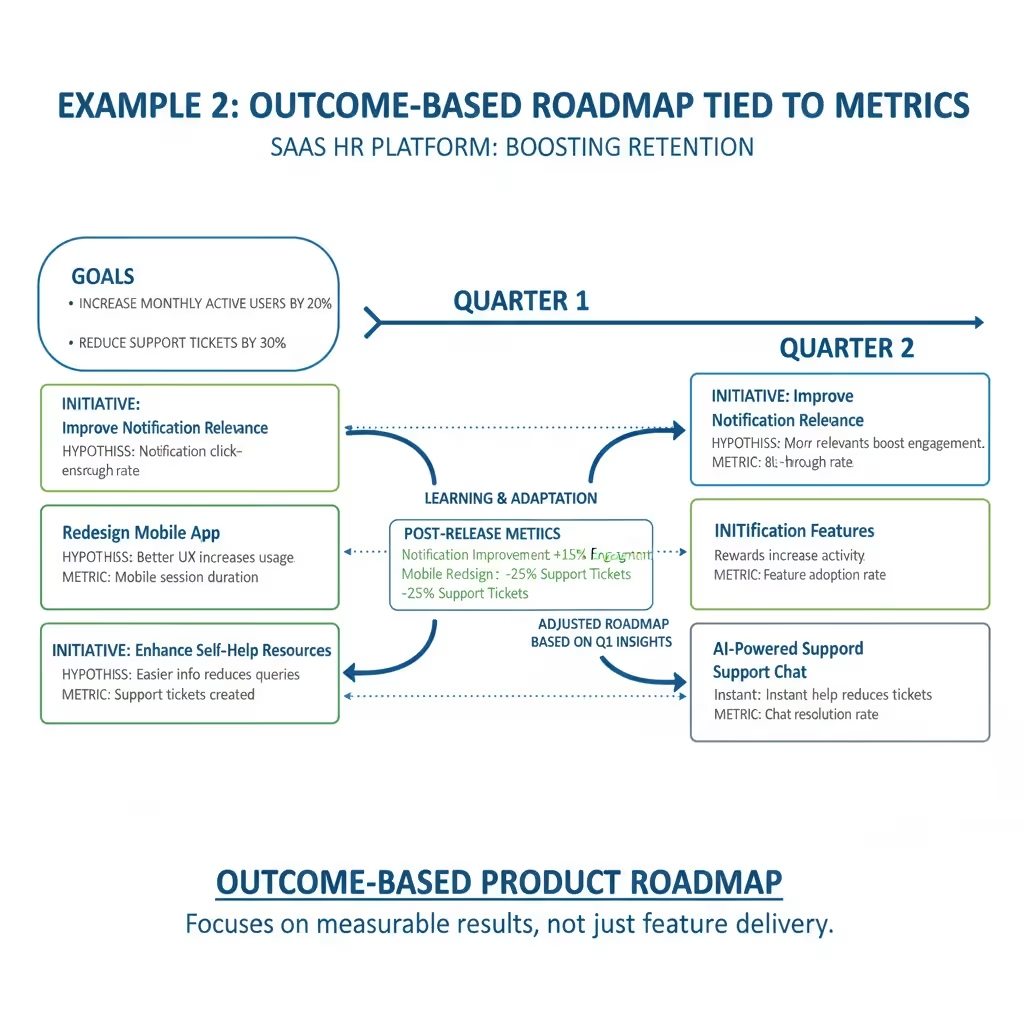How to Build a Product Roadmap: Complete Guide (2025)
Discover the steps to build a product roadmap, from defining goals to prioritizing features and communicating with stakeholders.

As a founder or product lead you might be tempted to improvise. That approach often works in the very beginning when your team is tiny and you can hold the entire vision in your head. But as you hire engineers, designers and marketers the absence of a plan starts to hurt.
Without a road map you risk wasting resources on features that don’t move the business forward, confusing your team about priorities and letting opportunities slip by. I’ve seen this first hand: clients who were shipping fast but asked me later why none of it stuck.
In this piece I’ll talk to those of you building early‑stage machine‑learning and SaaS products—founders, product managers and heads of design/engineering. We’ll cover goal setting, feature prioritisation, stakeholder agreement, timeline planning, risk and metrics. We’ll also explain how to build product roadmap foundations in plain language and why it matters now.
What is a product road map and why it matters
A product roadmap is a high-level plan that shows where a product is headed and how it will get there. Think of it as a visual outline that explains the product’s direction, priorities, and timeline over weeks, months, or even years.
It usually includes:
- Vision and goals: Why the product exists and what it’s trying to achieve.
- Major features or initiatives: The big things the team plans to build or improve.
- Timeline: When those things are expected to happen (though exact dates aren’t always locked in).
- Dependencies and priorities: What needs to come first, and what’s most important.

Atlassian describes a product road map as “a shared source of truth” that outlines your vision, direction, priorities and progress. Roadmunk calls it a visual communication tool that smooths coordination, improves strategic organisation and centralises collaboration. To me it’s a conversation starter: a simple document that tells your team what you’re working on, why it matters and when you expect to tackle it. A good road map links short‑term efforts to long‑term goals and adapts as you learn. Without that link you end up with a list of features that don’t add up.
Road maps serve several purposes:
- Communicate vision and strategy. They connect day‑to‑day tasks to a bigger purpose. Atlassian notes that items on the map should be clearly tied to product strategy and goals.
- Bring teams together around priorities. Product owners use road maps to build consensus on how the product will grow and shift over time.
- Plan development and make trade‑offs. A map helps you sequence work, understand dependencies and decide what not to build.
- Set expectations with stakeholders. Road maps provide a big‑picture, easily digested view for execs, sales teams and customers.
- Provide focus for engineers. By seeing the “big picture,” developers can avoid scope creep and make faster decisions.
There are several types of road maps:
- Internal vs external. Internal road maps are for your team and leadership; external versions give customers a glimpse of what’s coming without committing to dates.
- Executive vs development. Executive views show how work connects to company goals and metrics. Development road maps contain more detail about prioritised customer value, release milestones and sprints.
- Feature‑based vs outcome‑based. Feature road maps lay out specific releases; outcome‑based ones group work by desired results (e.g., improve onboarding completion). Agile teams often use Now‑Next‑Later structures rather than fixed dates.
The choice depends on your audience. Execs need clarity and an overview; engineers need enough detail to act. Customers need inspiration without false promises. Regardless of format, view the road map as a living document rather than a rigid contract.
Step #1: Plan before you build

1) Clarify your vision and goals
Before you open a road‑mapping tool, you need direction. What problem are you solving? For whom? How will you know you’ve succeeded? Talk about this with your co‑founders and early customers. If the vision isn’t clear, any road map will feel arbitrary. Tie your product vision to company goals such as revenue, growth or retention. Set measurable targets using KPIs and OKRs (objectives and results) or a single “North Star” metric. Recent research from ProductPlan’s 2024 report found that 76% of product professionals prioritise product strategy and 58 % view road‑mapping as a major investment. That means most teams see a map as an instrument to drive strategic outcomes, not just a schedule.
Define what success looks like. For example, if you’re building a B2B SaaS tool, success might be 30% month‑on‑month user growth with a churn rate below 5%. A good road map ties every initiative back to these metrics. Resist the temptation to include features simply because competitors have them. Instead ask: does this move us closer to our goal?
2) Understand your users
Good product decisions start with understanding who you’re serving. Identify your primary user personas. Conduct interviews, send surveys and analyse usage data. Look for patterns: what are the biggest pain points? Which tasks cause confusion or drop‑off? When we helped a machine‑learning analytics startup redesign onboarding, we learned through usability tests that users were abandoning the process after step two. That insight led us to simplify the flow and emphasise the core value proposition. Without those conversations, our road map would have prioritised polishing secondary features. Use research to decide which problems are worth solving now and which can wait.
3) Study the market
Map out your competitive environment. What alternatives exist? How are other products priced and positioned? Are there adjacent trends—like generative machine‑learning or privacy regulations—that create new opportunities or threats? Reading industry reports, attending conferences and talking to customers will surface these insights. They should inform both your vision and your road map. For example, if a competitor is releasing a similar feature next quarter, you may choose to focus on a differentiator instead of a me‑too release.
4) Assess resources and constraints
Take an honest look at your resources: team size, skills, budget and tooling. Identify technical dependencies and areas of debt. Be realistic about bandwidth and timelines. A common mistake in early‑stage teams is to commit to too many initiatives at once. When in doubt, cut scope. Also consider constraints outside your control—integrations, regulations, infrastructure—and plan buffers accordingly.
Step #2: Prioritise features and initiatives
Once you know where you’re going and why, the next challenge is deciding what to do first. Here are some practical frameworks I’ve used:
- Impact vs effort. Plot potential features on a matrix based on expected customer impact and required effort. High‑impact, low‑effort items are quick wins; high‑impact, high‑effort items become longer‑term bets. Low‑impact items usually fall off.

- RICE: Reach, Impact, Confidence, Effort. Assign scores for how many users it affects, how big the benefit is, how confident you are in your assumptions and how much effort it will take. Multiply Reach × Impact × Confidence and divide by Effort. Sort by the resulting value.

- MoSCoW: Must‑have, Should‑have, Could‑have, Won’t‑have. Use this to clarify what is non‑negotiable (compliance, security) versus what can be deferred.

- WSJF (Weighted Shortest Job First) from the Scaled Agile Framework. Divide the cost of delay by job size. The highest WSJF should be tackled first.

In practice I combine these frameworks with user feedback, strategic fit and risk. For each idea ask: does this solve a top user problem? Does it help us hit our goals? What happens if we defer it? Assign scores if necessary. Then group related features into themes or epics—for example, onboarding experience, performance improvements, or growth initiatives. Breaking big ideas into smaller deliverable batches reduces risk and lets you learn faster.
Manage risk
Every road map carries uncertainty: technical feasibility, market shifts, dependencies or resource fluctuations. Identify risks early and make them explicit. If you’re adopting a new technology, allocate time for prototyping. If your timeline relies on a partner’s API, have a backup plan. Build buffers into your schedule for unforeseen work. Consider running small experiments before committing to a major feature. For instance, release a minimum viable version to a handful of customers and measure adoption. Based on the results you can adjust the priority or refine the scope.
Step #3: Structure your timeline
Many early‑stage teams ask how to build product roadmap schedules without feeling locked into deadlines. My answer is to focus on time horizons rather than exact dates. I like the Now–Next–Later model: list what you’re tackling in the next quarter, what’s on deck and what’s on the horizon. This approach helps you communicate priorities while keeping room for learning and change. For organisations that require date‑driven plans, group work by quarters or months but emphasise that dates are targets, not promises.
When estimating effort, involve the people who will do the work. Developers, designers and QA often see dependencies and constraints that are invisible to leadership. Use relative sizing (e.g., story points) rather than exact hours for early estimates. Sequence features so that dependencies are resolved; for example, you can’t roll out advanced analytics until your data pipeline is stable.
Always plan buffers. Early‑stage projects are full of unknowns, so allocate slack to absorb unexpected complexities. Resist the temptation to schedule back‑to‑back initiatives. A thin buffer can cause your entire road map to slip when one item overruns. In our projects we typically allocate 20–30 % contingency in each phase, though the exact number depends on technical risk and team familiarity.
Step #4: Involve and communicate with stakeholders
Your road map isn’t only for the product team. Identify stakeholders: founders, leadership, engineering, design, sales, marketing, customer support and even important customers. Each group will have different concerns. Leadership cares about how work connects to company goals and metrics. Sales wants to know what’s coming so they can set expectations with prospects. Engineering needs clarity on priorities and sequencing. Customers appreciate transparency but not unrealistic promises.
Get stakeholders involved early. Share drafts, gather feedback and incorporate it where appropriate. Facilitate workshops to prioritise initiatives collectively rather than dictating from the top. This builds trust and ensures the road map reflects different perspectives. When conflicts arise—for example, marketing pushes for a splashy feature that engineering calls risky—refer back to your defined goals and success metrics. Explain trade‑offs. Sometimes the right call is to delay a flashy feature in favour of stability. Clear communication about why builds credibility.
Present different versions of the road map for different audiences. For executives, keep it big‑picture: themes, goals, metrics and broad time frames. For the development team, include more granularity about epics, dependencies and sprint plans. For customers or sales, focus on benefits and avoid binding dates. Use visuals like timelines, swimlanes or Kanban boards. What matters most is clarity. Too much detail will confuse; too little will feel vague. Adapt the depth to the audience and don’t bury the message.
Step #5: Execute, monitor and adapt
A road map is only as good as the execution behind it. Once you’ve prioritised and scheduled your initiatives, break them down into actionable deliverables: epics, user stories and tasks. Assign owners and ensure everyone knows what they’re responsible for and when. Use sprint planning and retrospectives to maintain momentum.
Track metrics and close feedback loops
Earlier we defined success metrics. Now you need to track them. Use product analytics to monitor usage, feature adoption, conversion rates and retention. Collect qualitative feedback through interviews, surveys and support tickets. Monitor KPIs regularly—weekly or monthly—so you catch issues early. For instance, if a newly launched onboarding flow doesn’t reduce time to first value, investigate why. Maybe users are still confused by jargon or the tutorial is too long.
Adjust your road map when things change
Markets shift, competitors move, and internal resources fluctuate. Consider your road map a living document. According to Atlassian, road maps should be updated as often as necessary—even weekly—so they remain an accurate source of truth. If a high‑priority feature slips because of technical hurdles, communicate the change and adjust subsequent initiatives. If user research reveals a new pain point, reorder the backlog. Keep a cadence for review—monthly or quarterly depending on your pace. During those reviews, revisit goals, metrics and assumptions. Did we achieve the impact we expected? Do we need to pivot? This flexibility is what makes a road map useful rather than ceremonial.
Best practices and pitfalls
Best practices
- Keep it simple. Only include the amount of detail needed for the audience. Atlassian says that a well‑crafted map balances short‑term tactics with long‑term goals and is updated regularly.
- Connect to vision and metrics. Every item on the map should tie back to your product vision and success metrics.
- View the map as a living document. Update it often and be transparent about changes.
- Stay connected with stakeholders. Regularly communicate updates and gather feedback.
- Use the right tools. Choose a tool that fits your stage, team size and budget—don’t over‑optimise early on.
Common pitfalls
- Locking in rigid deadlines too early. Don’t commit to dates until you’ve validated assumptions. Use time horizons instead.
- Overloading the map with features. Focus on outcomes over outputs. Too many features can dilute impact.
- Working in isolation. A road map created without stakeholder input breeds distrust and misses important perspectives.
- Letting the map get stale. An outdated map erodes trust and encourages back‑channel communication.
Tools and templates
Several tools can help you create and maintain road maps. Here are a few examples, from simple to advanced:
- Spreadsheets and slide decks. For very early teams, a shared spreadsheet or presentation might suffice. It’s free and flexible but manual.
- Trello and Jira. Kanban boards like Trello are easy for tracking tasks and simple Now‑Next‑Later views. Jira includes both backlog management and road‑mapping features integrated with sprints.
- Productboard. Offers a structured way to collect customer feedback, prioritise features and build visual road maps. Their materials emphasise clarity and direction.
- airfocus and Craft.io. Provide scoring systems (RICE, WSJF) and collaborative prioritisation.
- Aha! and Roadmunk. Offer advanced visualisation options, portfolio management and integration with engineering tools.
When picking a tool consider ease of use, collaboration features, integration with your existing stack, pricing and the ability to adapt as your organisation grows. As the ProductPlan survey showed, many product professionals want strategy and road‑mapping in the same platform. But don’t get bogged down in tool selection. A well‑thought‑out road map on paper is better than a messy one in a fancy tool.
In the end a tool is just a means to an end. The critical skill is knowing how to build a product roadmap with your team and stakeholders. Even a simple spreadsheet can work if everyone understands the vision, priorities and metrics.
Case examples
Example 1: Feature‑based map for an early machine‑learning startup

An early‑stage machine‑learning analytics startup approached us with an overwhelming list of feature requests. We worked with the founders to define a clear vision: help business teams get insights without writing queries. Success meant reducing time to insight from one day to five minutes. We ran interviews with ten pilot customers and found that most frustration came from data import and onboarding. Our first road map focused on a few critical features: automated CSV imports (high impact, low effort), guided onboarding (medium effort) and a shareable dashboard (high impact, high effort) scheduled for “Later.” We grouped the work into themes—“Data ingestion” and “User onboarding”—and used a Now‑Next‑Later structure. Within three months the team released the first two features and saw a 50 % reduction in setup time. The more ambitious dashboard remained on the map but moved to a later horizon based on capacity and feedback. This example illustrates how to build product roadmap elements from research to prioritisation.
Example 2: Outcome‑based map tied to metrics

Another client, a SaaS HR platform, wanted to boost retention. Instead of listing features, we defined outcomes: increase monthly active users by 20 % and reduce support tickets by 30 %. We mapped initiatives to these outcomes—improve notification relevance, redesign the mobile app, enhance self‑help resources. Each initiative included a hypothesis and metric. We scheduled them over two quarters, leaving a buffer for learning. After each release, we measured progress; notification improvements increased engagement by 15 %, while the mobile redesign reduced support tickets by 25 %. We used those insights to adjust the rest of the road map. This approach shows how to build a product roadmap around outcomes rather than outputs.
Example 3: Pivoting mid‑road map

Sometimes road maps need dramatic change. A fintech client planned to build a new payment gateway. Midway through, new regulations made the planned integration unviable. Rather than forcing through, we paused and revisited the road map. We evaluated alternative solutions and decided to partner with an established provider instead of building in‑house. This decision freed up resources for other projects and ensured compliance. We updated the road map, communicated the pivot to stakeholders and adjusted the timeline. By embracing flexibility, we avoided wasted effort and delivered value sooner. This is another example of how to build a product roadmap that adapts to external changes.
Conclusion
Building a product road map isn’t about drawing a pretty timeline; it’s about making hard choices transparent and tying your work to real outcomes. Start by clarifying your vision and goals, then invest in user research and market understanding. Prioritise features using structured frameworks and manage risk by breaking work into small, testable units.
Structure your timeline around horizons rather than hard dates and plan buffers. Engage stakeholders early and often; shape your message to the audience and view the road map as a living document. Use tools that fit your stage, but don’t let them dictate your thinking. Most importantly, stay flexible: your first road map will be wrong in places, and that’s fine. The goal is not to predict the future but to create a shared narrative that guides your team forward.
FAQ
1) How do you build a product map?
The term “product map” is often used interchangeably with “road map,” though some teams use it to mean a more detailed mapping of features and user flows. To build one, start by clarifying your product vision and business goals. Map out user paths and identify pain points through research. List potential features and prioritise them using frameworks like RICE or impact‑versus‑effort. Group related items into themes or stages. Then place them on a timeline (Now–Next–Later works well) and communicate it to your team and stakeholders. Adjust as you learn. This process is how to build a product roadmap that serves as both a strategic and operational guide.
2) What are the three components of a product road map?
At its most basic a road map has three essential parts: Goals or desired outcomes, initiatives or features that contribute to those outcomes and a timeline or ordering that indicates when you plan to work on them. Some teams add metrics or themes to track progress and organise work. Keeping these components clear helps stakeholders understand why each item exists and when it might happen.
3) What tools help create product road maps?
Tools range from simple spreadsheets to purpose‑built platforms. Spreadsheets and slide decks work for small teams or early drafts. Trello and Jira provide basic backlog and Kanban views; you can create simple road maps with labels or swimlanes. Productboard, airfocus, Craft.io, Aha! and Roadmunk offer more advanced features like scoring, feedback integration and visual templates. Choose a tool based on ease of use, collaboration needs and integration with your development workflow. Data from the 2024 ProductPlan survey shows that many professionals expect road‑mapping and strategy features to be combined in the same platform.
4) How does a product owner create a road map?
A product owner gathers inputs from multiple sources—company strategy, user research, market analysis and team capabilities. They prioritise initiatives using structured criteria and map them to a timeline. They then collaborate with stakeholders to refine the plan, communicate it clearly and adjust it as new data arrives. The product owner owns the trade‑offs and ensures that the map reflects the most important goals at any given time.
5) How often should a product road map be updated?
Update your road map whenever there’s new information that affects priorities—new market insights, significant user feedback, technical blockers or strategic shifts. Atlassian suggests updating as often as necessary, even weekly, to keep the map an accurate source of truth. At a minimum, schedule formal reviews each quarter to revisit goals, metrics and assumptions. Updating regularly builds trust with your team and stakeholders and ensures your decisions are grounded in current reality. Frequent revision also demonstrates how to build product roadmap discipline in the face of uncertainty.



.avif)









